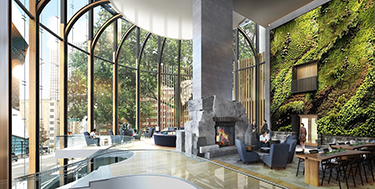|
Subscribe / Renew |
|
|
Contact Us |
|
| ► Subscribe to our Free Weekly Newsletter | |
| home | Welcome, sign in or click here to subscribe. | login |
Real Estate
| |
 |
December 12, 2013
Survey: Schnitzer West
Specialty: Property development, management and acquisition
Management: Pam Hirsch and Greg MacDiarmid, regional operating partners
Founded: 1997
Headquarters: Seattle
Projects: Madison Centre, a 750,000-square-foot office building in downtown Seattle; 501 Fairview, a 300,000-square-foot office building in South Lake Union
Although South Lake Union has seen a large upsurge in development since the early 2000s, Schnitzer West still sees plenty of opportunity in the area on the north end of downtown Seattle.
Schnitzer West has a 300,000-square-foot office/retail development in the permitting phase that it plans to start next year in South Lake Union.
Recent changes to the floor area ratio restrictions in South Lake Union means that Schnitzer West can maximize the building area in its 12-story office. That will result in a taller building offering better views, according to Pam Hirsch, senior investment director at Schnitzer West.
“The upzone improved, fairly significantly, the dynamic of the South Lake Union market,” said Hirsch, noting that previous height restrictions would have meant a building only five stories tall. “We don’t think South Lake Union is fully built-out yet.”
Record sales prices
South Lake Union is just one area where Schnitzer West sees potential, according to Hirsch. She said the “whole ecosystem” of local tech and retail companies such as Microsoft and Amazon are the underpinnings of a strong recovery for commercial real estate in the Puget Sound region.
Schnitzer West focuses on multifamily and office development, building projects from the ground-up and also purchasing properties.
“We’re getting record sale pricing on almost every transaction,” said Pete Aparico, investment director at Schnitzer West. “We’re seeing heavy institutional interest and an increase in interest from the foreign buyer pool.”
Case in point is Schnitzer West’s recent sale of 712,000 square feet in office buildings at Schnitzer West’s North Creek Campus in Bothell to U.K-based Grosvenor Americas for $167 million. The deal included 11 buildings on the corporate campus.
“We had a strong buyer pool,” said Aparico. He said Grosvenor wanted to expand its office building portfolio into the Puget Sound area. “They have a strong belief in the strength of the Puget Sound market,” he said.
Schnitzer West purchased the Bothell property in the late 1990s, and did the bulk of the redevelopment in the early 2000s, with an additional 105,000-square-foot building in 2009.
“We stuck to our rigorous investment thesis and it was a good time for us to sell,” Aparico said.
Schnitzer West used CBRE as its broker for the Bothell sale.
Big buildings
Schnitzer West also closed recently on a $474.5 million deal to sell Bravern Signature Residences in Bellevue’s central business district. Schnitzer West bought the land in 2000 and developed the 455 units in two 33-story towers, as well as two office buildings. Schnitzer West sold the 750,000-square-foot office space in 2010.
Schnitzer West will remain as the property manager for the North Creek office campus space, and will also be property manager for The Shops at the Bravern and the Bravern Office Commons.
Schnitzer West is also developing a 16-story, 360,000-square-foot office building in downtown Bellevue, due for construction late next year. Its 750,000-square-foot office tower, Madison Centre in downtown Seattle, will also begin construction next year.
Upbeat office outlook
Hirsch said Schnitzer West in 2008 and 2009 was not seeking buyers for its properties because of constraints on the capital market. But 2010 presented new opportunities, she said. “We started seeing office transactions pick up pace in late 2010,” she said.
Hirsch said she sees opportunity in the next couple of years for continued growth in office space due to investors’ willingness to jump in. “The fundamentals are very strong,” she said.
At the same time, she said companies are redefining the way buildings are used. Tenants want more employees to fit into less space, and in return they are willing to offer greater amenities. For example, common areas such as lobbies can be put to use as workspaces or employee break-out areas where meetings are held. “Employers want to stretch the limits of how useful a building can be,” she said.
Other Stories:
- Empty strip mall? Here’s how to fill it
- Survey: Urban Visions
- Survey: Thomas Co.
- Survey: Barrientos LLC
- Survey: Wright Runstad and Co.
- Survey: Flinn Ferguson
- Survey: Lake Union Partners
- State of the Market: Fledgling tech likes ‘gritty’ office buildings
- State of the Market: Is a banner year on tap for industrial properties?
- State of the Market: Retailers cash in on strong local market
- State of the Market: Multifamily rides Seattle’s strong job market
- Easements: Not just for highways and driveways
- 40-year-old plan could amp up downtown livability
- Commercial property owners deal with rising flood insurance
- Survey: Wallace Properties



